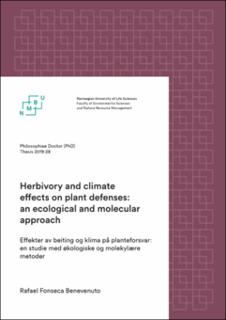| dc.description.abstract | Knowledge of plant defense responses and how they interact with biotic (e.g., herbivores) and abiotic (e.g., temperature) factors is of fundamental importance for understanding ecosystem functioning. Increases in temperature can dramatically weaken plant immune systems, and thereby cause elevated herbivory rates. On the other hand, rising temperatures can make plants more alert, and consequently result in investment in more effective defense strategies. Such adaptation can potentially influence plant-animal and plant-plant interactions. The effects of climate change on plant defenses can have particularly strong impacts on biodiversity and ecosystem functioning of vulnerable high-latitude systems. The boreal forest is the dominant biome in Fennoscandia (the Scandinavian peninsula and Finland), where bilberry (Vaccinium myrtillus L.), a widely distributed dwarf shrub, is considered to be a key food source for many species, and an excellent model organism for ecological studies in the boreal system.
The main objective of this thesis is to explore bilberry defense responses through plant-herbivore and plant-plant interactions, as well as investigate how these relationships are affected by environmental variation. To investigate this, we experimentally treated bilberry ramets with methyl jasmonate (MeJA) to simulate herbivory and induce plant defenses. Subsequently we observed ecological and molecular responses in relation to growth, reproduction and defense along an elevational gradient in a boreal system in Western Norway. The elevational gradient design mainly reflected variation in temperature and snow cover, and included optimal growing conditions for bilberry (ca. 500 m a.s.l.; mid-montane zone), as well as the plants’ range limits at low (ca. 100 m a.s.l.; submontane zone) and high (ca. 900 m a.s.l.; subalpine zone) altitudes.
We observed that MeJA-induced defenses in bilberry plants effectively reduced insect and mammalian herbivory, as well as growth and reproduction across the three years of study. Such findings provide evidence for an effective ecological trade-off between growth/reproduction and defense over multiple seasons. Interestingly, bilberry induced defense systems occurred in a delayed manner, with the strongest effects from one (insect herbivores) to two (mammalian herbivores) years after induction. We also provide evidence of long-term effects on plant-plant communication, indicating that MeJA-induced bilberry plants are “good” neighbors, due to ecological facilitation with conspecifics in the boreal system (Paper I). Subsequently, we reported such a trade-off at transcriptional level, which I termed a ‘genetic trade-off’, highlighting molecular mechanisms underpinning and supporting our previous field observations (Paper II).
We found that bilberry defense responses are modulated by the altitudinal variation in climate and herbivory at both molecular and ecological levels. High-altitude plants living under cooler temperatures and limiting resource availability invest more in constitutive defenses, whereas low-altitude plants growing under higher temperatures and herbivory pressure rely strongly on induced defenses (Paper III). Environmental variation along the elevational gradient also affected plant-plant communication. Suboptimal lower (warmer submontane zone) and optimal medium-altitude (mid-montane zones) environments in the boreal system favored the facilitation of defense-induced plants with long distanced conspecifics; as compared to the suboptimal upper elevation (colder subalpine zone) (Paper IV). The greater prominence of this inducible plant defense system at lower altitudes may presage the kinds of change expected in plant-plant communication systems and associated VOC emissions in a warmer world, which will likely feedback to further influence ecological functioning. Such findings support previous observations that under increasingly warmer conditions and higher herbivory pressure, bilberry plants are more responsive to herbivory by strongly relying on induced defenses against future attacks.
In this thesis we document that multiannual induced defenses in bilberry plants cause resource allocation from growth and reproduction to defense (trade-off), also seen at gene level, with its strongest effect delayed. We also report that altitudinal variation modulated defense capacity, where plants from warmer low/medium altitudes were more responsive to induced defenses in terms of plant-herbivore and plant-plant interactions. Due to rapid global warming, higher elevations are likely to become the new optimal growing environment for bilberry in the near future. Therefore, if low-altitude plants migrate to higher elevations, they will need to readapt to novel biotic (e.g. less diversity and herbivory pressure) and abiotic (e.g. harsher environment and less resource availability) conditions. Furthermore, abundance of ‘more-defended’ plants in subalpine zones can affect herbivore population dynamics, by limiting cycle amplitude due to higher levels of defense during the growing season. Such a combination of events in response to climate change might catalyze new ecological and co-evolutionary dynamics in the boreal system. | en_US |

